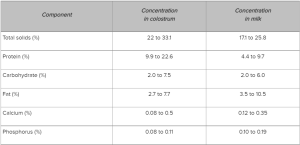Piglet Care[1]
A heat lamp should be provided in a section of the farrowing box so that the piglets may seek warmer temperatures while allowing the sow to stay cool. Ideal piglet temperature is between 80-90oF (26-32oC) for the first 2 weeks of life. Care should be taken not have the heat lamp too close so that it burns the piglets, and the cord should be well out of reach of the piglets and dam. Ensuring that all piglets have access to the dam’s teats in the first hours of life is crucial for colostrum consumption. A typical sows colostrum and milk composition is listed in the table below.[2] Colostrum and milk replacers, if needed, should resemble the compositions listed with protein from milk derived sources rather than plant sources. Copper and iron (not listed) are normally very low in pig milk and cannot be increased by supplementing the sow with them. In a natural outdoor setting, adequate amounts of iron are gained from the soil. To compensate for this, an iron injection can be given to each piglet within the first 5 days after birth. A prevention dose for production swine is 100mg IM between 2 and 4 days of birth. Since most pet pigs are considerable smaller than a commercial piglet, a smaller dose (50mg) would likely be sufficient.[3] This dose can be repeated in 10 days if iron deficiency anemia is suspected. Another option is to have fresh dirt available after parturition for the piglets to root in. This practice however can increase the risk for GI parasites. Clinical signs of copper deficiency are rare and copper supplementation is generally not needed.[4]

Weaning age depends on the dam, if she is losing weight, hypocalcemic, aggressive towards piglets, or is not producing milk the piglets may have to be weaned early. In general weaning should be a slow process but the way this is done can vary greatly.Introducing a creep feed at about 1 week of age is a good idea. Easing the piglets into weaning by removing piglets from the sow daily for short periods of time and increasing the time each day is a good idea. Leaving any runts with the sow and removing the others can be a good way to ensure that the runts get enough milk. Additionally, removing a single piglet at a time can be good for one-on-one interactions. Socializing the piglets with other animals in the house is also a good idea. Increasing the time the piglets are without their mother and feeding them a piglet diet can help dry off the dam. Weaning the largest piglets first and then the smaller ones over the course of a couple weeks is also good to help dry off the sow and reduce the risk of mastitis. The piglets should be fully weaned at least 2 weeks prior to being rehomed.[5]
See Chapter 3 for more information on piglet nutrition.
Pigs are very intelligent creatures and can be easily trained to living in the house. Pigs are very food motivated which also facilitates training, including proper elimination patterns.[6] Teaching a piglet to eliminate outside can be accomplished in a very similar way as with a puppy. Pigs do not like to sleep or eat where they have defecated, so crate training (as in puppies) can be a very effective means of potty training.
